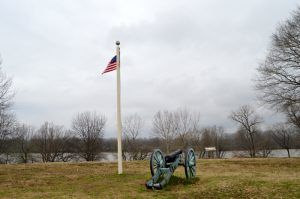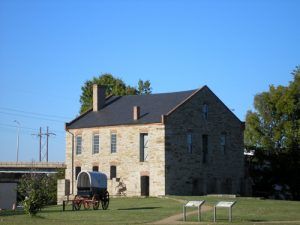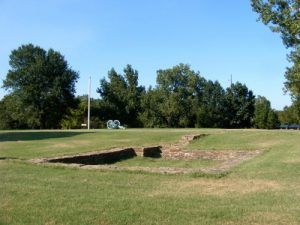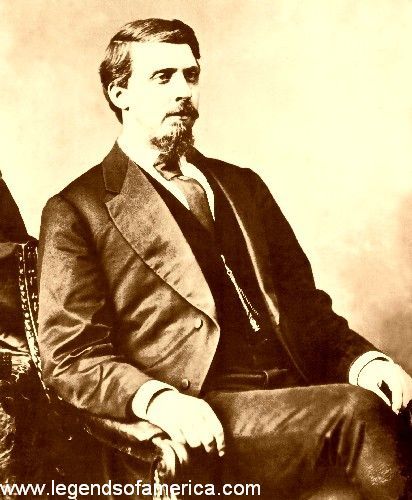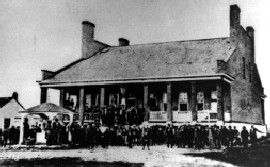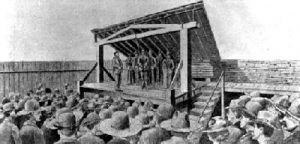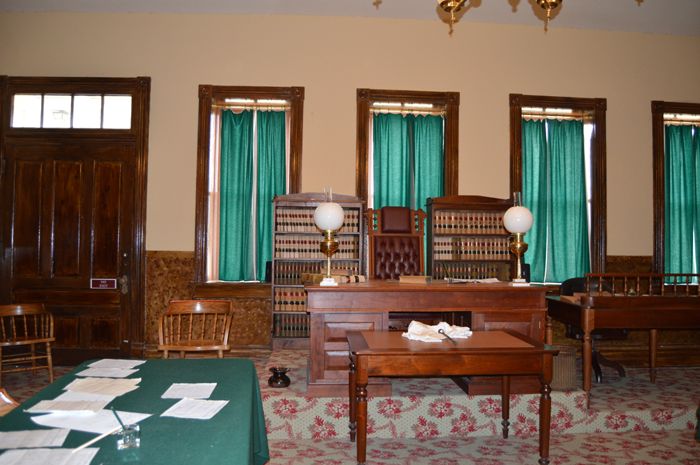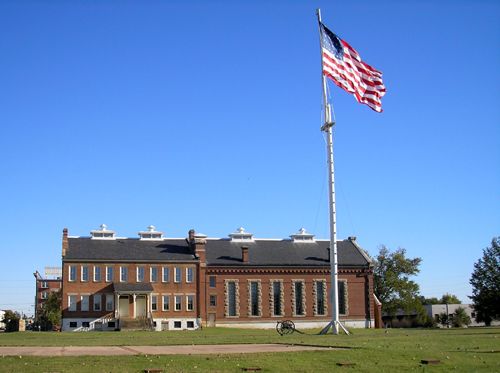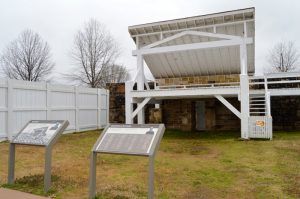On the isolated edge of the American Frontier, Fort Smith, Arkansas, was established on Christmas day, 1817. Under the command of Major William Bradford, the soldiers’ initial task was to keep the peace between the Cherokee and Osage tribes. The new fort site was Belle Point, a prominent bluff overlooking the Poteau and Arkansas Rivers.
Sixty-four men of the Rifle Regiment erected temporary shelters in just eight days and began the work on a permanent fortification. Construction progressed slowly, and upon completion, the fort was a simple log stockade with four sides at 132 feet each and two blockhouses at opposite angles. Barracks, storehouses, shops, a magazine, and a hospital were located within the walls.
Additional quarters were built outside the original fort in 1822 when increased hostilities between the Osage and Cherokee prompted the need for more soldiers. Two years later, however, the Federal Government determined that the fort’s location was too far away from the newly redefined Indian Territory (Oklahoma) and established Fort Gibson some 60 miles up the Arkansas River. As a result, the troops departed Fort Smith in 1824.
Three years later, the fort was slated to serve as the agency for the western Choctaw Indians, who were also forced to move to Indian Territory. When Choctaw agent William McClellan arrived in February 1827, he found the post buildings in bad condition. It would be four more years before the government would repair the structures. Finally, in April 1831, Lieutenant Gabriel Rains and a Seventh United States Infantry detail arrived at the post to begin the repairs. By August, Choctaw Indians began trickling into the area.
Just east of the post and adjacent to the Choctaw boundary line, a sizeable civilian community emerged on lands owned by John Rogers. Dominating the community were six taverns, where enterprising merchants supplied the emigrating Choctaw with cheap whiskey. Many displaced tribesmen settled nearby and became a source of sustained exploitation. Lieutenant Rains positioned his men on the boundary line to separate the peddlers and Choctaw, but the situation worsened. In March 1833, Captain John Stewart and a company of Seventh Infantry were garrisoned at the post to control the contraband trade, known as the “Arkansas Whiskey War.” He, too, met with little success as the merchants operated right under his very nose. As a result, Stuart abandoned Fort Smith in June 1834 and established Fort Coffee at a more suitable location in Indian Territory.
As additional tribes were relocated to Indian Territory, fearful residents of the new State of Arkansas requested a permanent military garrison be placed on their western border. In 1838, Congress authorized the construction of a new fort and purchased land from John Rogers to build a 296-acre reservation adjacent to the old fort on Belle Point.
In the spring of 1839, the construction of the new fort began. The design called for a pentagonal-shaped stone fort with a bastion at each angle, enclosing seven acres. Inside the wall, several buildings were situated around a parade ground, including two enlisted men’s barracks, two officer’s quarters, the commandant’s quarters, a hospital, the quartermaster store, and other buildings. This ambitious plan, however, would never be fully realized.
Because of events in the next six years, the army completed Fort Smith along many different lines. It had become apparent to the military that armed warriors would not descend on Arkansas from Indian Territory. Yet, hostilities threatened another frontier, and the Mexican-American War loomed on the horizon. Fort Smith was ideally situated to equip military units marching to the Rio Grande and to supply frontier posts in Indian Territory. Therefore, in 1845, the half-finished post was formally designated as a supply depot.
Without a need for defensive capabilities, portions of the fort curtain wall were never raised to the intended height of 12 feet. To accommodate the vastly increased supply load, the foundations of the incomplete Commandant’s Quarters and one of the enlisted men’s barracks were dismantled and used to convert two bastions into commissary and quartermaster storehouses. A third bastion was transformed into a magazine. Only two officers’ quarters and one enlisted men’s barracks fronted the parade ground upon completion. Several other structures were located beyond the fort walls, including maintenance buildings, stables, laundress quarters, a hospital, a storehouse, and a bakehouse.
Fort Smith was formally garrisoned in May 1846 and functioned as a supply depot throughout its 25-year-long occupation by the military. In the pre-Civil War years, national interests focused on westward expansion. New posts were established in Indian Territory, including Fort Towson and Fort Washita, which the depot at Fort Smith supplied.
On April 23, 1861, Arkansas State Troops occupied Fort Smith. Until September 1, 1863, when Federal soldiers re-garrisoned the post, Fort Smith served the Confederate Army of the Trans-Mississippi West as a significant supply base and defensive bastion protecting Southern interests in Arkansas and Indian Territory.
During the post-war years, the army again focused on renewed westward expansion. The line of frontier posts had moved so far to the west; however, supply lines from Fort Smith were stretched to capacity. The days of Fort Smith as a supply depot were numbered.
Other problems plagued the post and eventually caused its abandonment. Housing for the troops had always been in short supply, and on November 24, 1865, Officers Quarters A burned to the ground. Five years later, in December 1870, Officer Quarters B suffered the same fate. To the military, the role of Fort Smith as a supply depot was no longer tenable. On July 19, 1871, the Sixth Infantry marched out of the post, the last unit to garrison Fort Smith. Once again, however, the winds of fortune shifted and prolonged the life of the fort.
In 1872, the United States District Court of the Western District of Arkansas occupied Fort Smith. A valuation of the property indicated that 27 buildings stood on the former military reserve. Nearly all of these were relegated to civilian or federal use.
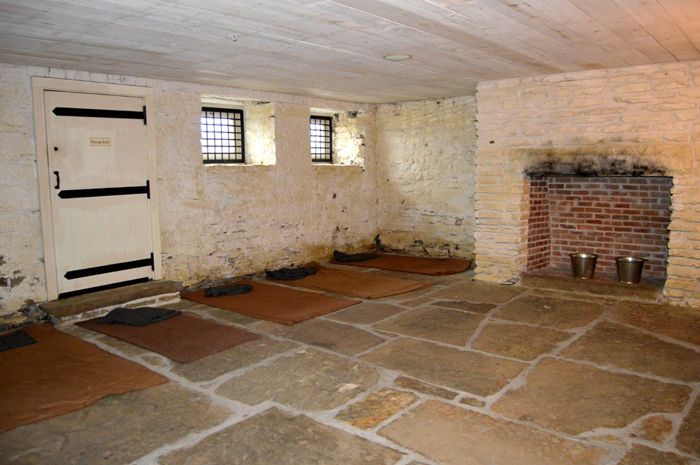
The old jail at Fort Smith was a miserable, cold, and overcrowded place for prisoners held there by Kathy Alexander.
The former enlisted men’s barracks became the Federal Courthouse and housed attendant offices. A permanent gallows was constructed along the inward side of Bastion 3, or the old magazine and the Federal Courthouse basement served as a jail. When overcrowding in this makeshift prison, known as “hell-on-the-border,” received adverse public attention, a modern prison wing was added to the south end of the courthouse. This structure was completed in February 1888.
The jurisdiction of the United States District Court of the Western District of Arkansas was a vast area encompassing western Arkansas and the entire Indian Territory of present-day Oklahoma. Here, tribal courts had no jurisdiction over non-Indian settlers. This legal detail gave an advantage to the most desperate breed of outlaw, who found refuge beyond the pale of justice and could murder and steal with little fear of retribution. A federal marshal and several deputies, never more than 200 strong, combed this wilderness to bring offenders to justice. When fugitives were apprehended, they were taken to Fort Smith for trial.
Fort Smith is best known for Federal Judge Isaac C. Parker, whom President Ulysses S. Grant appointed to the bench in 1875. Judge Isaac Parker arrived at Fort Smith on May 4, 1875, replacing Judge William Story, whose tenure had been marred by corruption.
For the next 21 years, Parker presided over 13,000 cases, and 79 offenders were hanged for their crimes, earning him the nickname of the “Hanging Judge.” Parker proved to be a tireless defender of Indian rights and, through his efforts, brought law and order to Indian Territory.
As the non-Indian population increased, new courts emerged in Indian Territory, gradually reducing Parker’s authority. On March 1, 1895, Congress enacted legislation that limited Parker’s jurisdiction to several counties in western Arkansas. This legislation became effective on September 1, 1896. The last execution there occurred shortly before that, on July 30.
Beginning during the time of the Federal Courthouse and continuing into the late 19th and early 20th centuries, a series of events changed the appearance of the historic fort. By the act of February 17, 1883, Congress granted rights-of-way through the former military reservation to the St. Louis and San Francisco Railroad.
Between May 1886 and February 1889, the railroad company removed a portion of the garrison wall to accommodate trackage, effectively separating the Quartermaster Building from the rest of the fort. The Missouri Pacific Railroad soon paralleled the St. Louis and San Francisco and cut through the fort.
A May 29, 1896 bill called for lands inside the garrison to be granted to the city of Fort Smith. Although the use of the Federal Jail continued as late as 1914, the government transferred the remainder of the military reserve to the city.
On February 26, 1897, Congress enacted legislation to extend Parker and Rogers Avenues and Third and Second Streets through this property. The Old Fort Reserve Addition was surveyed in June and sold to private concerns. The stone wall of the fort was dismantled between July 1, 1897, and July 1, 1898, after which time the streets were extended. By 1900, several sizeable multi-storied brick buildings had been built or were under construction, and the Old Fort Reserve Addition emerged as the light industrial and warehouse district of Fort Smith. The Courtroom/Jail complex became a civic center and housed various city offices and community organizations. Sometime around the turn of the century, Belle Point was densely populated and acquired the name “Coke Hill.” Coke Hill was a squatter settlement, and the individual plots of land were randomly oriented, ignoring the city of Fort Smith’s platted lot system.
Public interest in the old fort increased during the early 20th century. In 1910, the Old Fort Museum Association occupied the Commissary and used the building as a museum. In 1957, the courthouse was restored to its original condition. Local businessmen donated funds to purchase private interests on Coke Hill and, in 1958, sponsored the first archaeological excavation at the site. In 1961, the city of Fort Smith donated eleven acres of land containing the site of the first fort, the Courtroom/Jail complex, and the Commissary Building to the National Park Service. Since the creation of the Fort Smith National Historic Site, landholdings of up to 75 acres have been authorized, and several intrusive streets and post-historic buildings have been removed.
Today, the Fort Smith National Historic Site includes the remains of the two frontier forts and the Federal Court for the Western District of Arkansas.
Contact Information:
Fort Smith National Historic Site
P.O. Box 1406
301 Parker Avenue
Fort Smith, Arkansas 72901
479-783-3961
Is Fort Smith Haunted?
If its Old West reputation isn’t enough, the old courthouse is said to be haunted by none other than Judge Parker himself. Allegedly, many of those executed on these historic grounds are also said to lurk on the property.
Reader Update:
When I visited Fort Smith, Judge Parker’s Courthouse was closed, so I walked around the building a bit. Of course, my interest was drawn to the large gallows. I believe it was a replica, but I climbed the stairs and approached the cross beam when I suddenly felt this chill (on a very warm day) and felt it was an evil area. I quickly left and went to my nearby car. My wife, who also has a “sixth sense,” as I observed my movement on the scaffold, asked if I had felt something eerie, as she had. Maybe it is just a fluke, but some things cannot be explained. — D. Ward Gagner, Bangor, Maine, November 2007
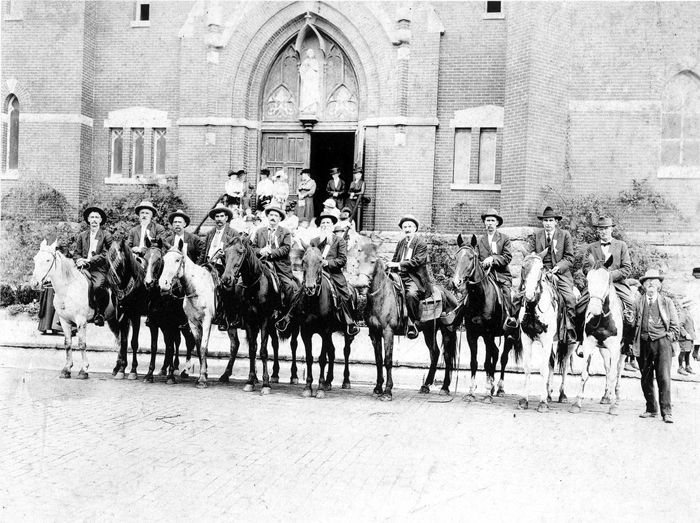
A reunion of deputy marshals was posed in front of Immaculate Conception Church on Garrison Avenue in Fort Smith.
Compiled and edited by Kathy Alexander/Legends of America, updated February 2024.
Also See:
Fannie Echols – First Woman Sentenced to Hang at Fort Smith
Isaac Parker, the “Hanging Judge”
George Maledon – Prince of Hangmen
Primary Source: National Park Service


